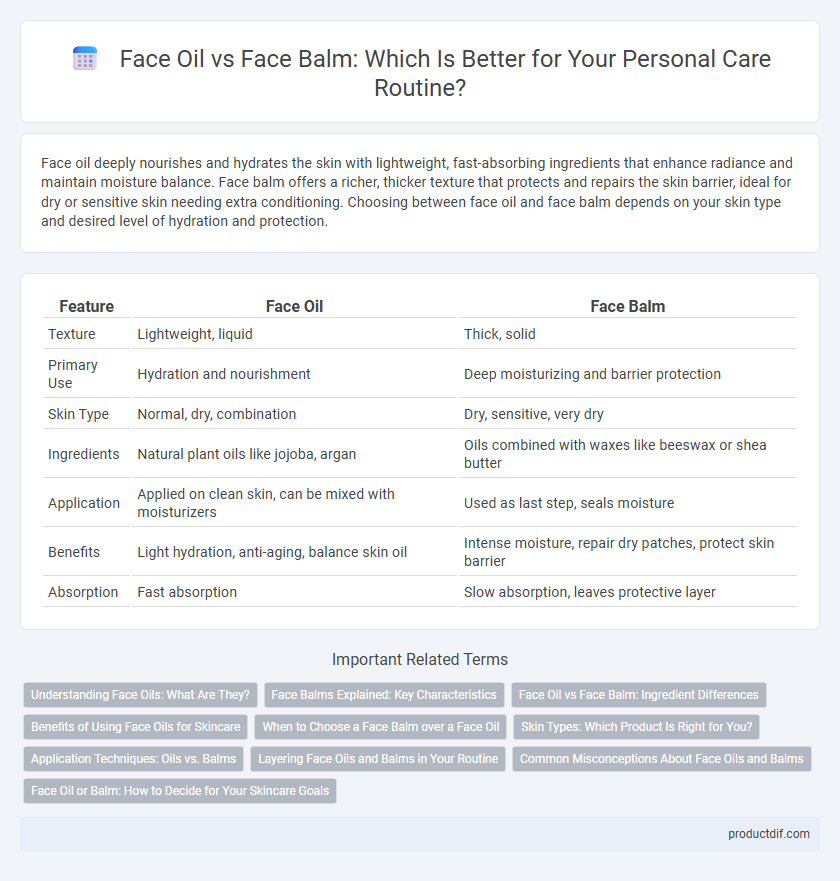Face oil deeply nourishes and hydrates the skin with lightweight, fast-absorbing ingredients that enhance radiance and maintain moisture balance. Face balm offers a richer, thicker texture that protects and repairs the skin barrier, ideal for dry or sensitive skin needing extra conditioning. Choosing between face oil and face balm depends on your skin type and desired level of hydration and protection.
Table of Comparison
| Feature | Face Oil | Face Balm |
|---|---|---|
| Texture | Lightweight, liquid | Thick, solid |
| Primary Use | Hydration and nourishment | Deep moisturizing and barrier protection |
| Skin Type | Normal, dry, combination | Dry, sensitive, very dry |
| Ingredients | Natural plant oils like jojoba, argan | Oils combined with waxes like beeswax or shea butter |
| Application | Applied on clean skin, can be mixed with moisturizers | Used as last step, seals moisture |
| Benefits | Light hydration, anti-aging, balance skin oil | Intense moisture, repair dry patches, protect skin barrier |
| Absorption | Fast absorption | Slow absorption, leaves protective layer |
Understanding Face Oils: What Are They?
Face oils are lightweight, nutrient-rich liquids extracted from plants, designed to nourish and hydrate the skin deeply without clogging pores. They contain essential fatty acids, antioxidants, and vitamins that help balance the skin's natural oils and improve elasticity. Unlike face balms, face oils absorb quickly, providing a non-greasy, radiant finish ideal for all skin types, particularly dry or mature skin.
Face Balms Explained: Key Characteristics
Face balms are rich, emollient skincare products designed to provide intense hydration and create a protective barrier on the skin. Unlike face oils, which primarily deliver concentrated nutrients and antioxidants, face balms contain a blend of natural butters, waxes, and oils that help lock in moisture and soothe dry, irritated skin. Their thicker texture makes them ideal for nighttime use or targeted areas needing extra nourishment and repair.
Face Oil vs Face Balm: Ingredient Differences
Face oils primarily consist of lightweight botanical oils like jojoba, rosehip, and argan, designed to penetrate deeply and deliver intense hydration and antioxidants to the skin. Face balms contain a richer blend of occlusive ingredients such as beeswax, shea butter, and carrier oils, forming a protective barrier that locks in moisture and soothes dry or irritated skin. The key ingredient difference lies in the oil's fluid texture promoting absorption versus the balm's solid form providing long-lasting skin protection and nourishment.
Benefits of Using Face Oils for Skincare
Face oils are rich in antioxidants, essential fatty acids, and vitamins that deeply nourish and hydrate the skin, promoting a radiant and youthful complexion. They help balance natural oil production, reduce inflammation, and provide a protective barrier against environmental stressors like pollution and harsh weather. Unlike face balms, face oils absorb quickly without leaving a heavy residue, making them ideal for all skin types, especially for enhancing skin elasticity and improving overall texture.
When to Choose a Face Balm over a Face Oil
Face balm is ideal for dry or sensitive skin types needing intense hydration and protection, especially during cold or harsh weather conditions. It creates a thicker barrier that locks in moisture more effectively than face oil, making it suitable for nighttime use or when skin feels particularly dehydrated. Opt for a face balm over face oil when you require a soothing, occlusive product that promotes skin repair and reduces moisture loss.
Skin Types: Which Product Is Right for You?
Face oil is ideal for dry and mature skin, as it delivers deep hydration and helps restore the skin's natural barrier with essential fatty acids and antioxidants. Face balm suits sensitive and combination skin by providing a protective layer that locks in moisture without clogging pores, often containing soothing ingredients like shea butter and beeswax. Choosing the right product depends on your skin's needs: face oils nourish and rejuvenate dry skin, while face balms offer gentle, long-lasting moisture for sensitive or mixed skin types.
Application Techniques: Oils vs. Balms
Face oils absorb quickly and are best applied by warming a few drops between fingertips before gently pressing onto cleansed skin for optimal hydration. Face balms require melting between palms to transform into an emollient texture, allowing deeper nourishment through slow, circular massage motions especially on dry or chapped areas. Both application techniques enhance product penetration but serve different skin needs--oil for lightweight, fast absorption and balm for intensive barrier repair.
Layering Face Oils and Balms in Your Routine
Face oils provide lightweight hydration and penetrate quickly, making them ideal for layering under moisturizers or balms, which offer heavier occlusive properties to lock in moisture. Combining a nourishing face oil like jojoba or rosehip with a rich balm containing shea butter or beeswax enhances skin barrier protection and long-lasting hydration. Proper layering sequence starts with face oil for absorption, followed by balm to seal moisture and improve overall skin texture.
Common Misconceptions About Face Oils and Balms
Face oils and face balms are often misunderstood, with many assuming face oils are greasy and unsuitable for oily skin, while balms are only for dry skin. Face oils can balance sebum production by providing essential fatty acids, and balms offer a protective barrier with concentrated nutrients without clogging pores. Both products serve distinct purposes in skincare routines, catering to different skin types and conditions despite common misconceptions.
Face Oil or Balm: How to Decide for Your Skincare Goals
Face oils deliver concentrated nutrients and antioxidants that deeply hydrate and rejuvenate the skin, making them ideal for targeting dryness and aging signs. Face balms offer a thicker, occlusive layer that locks in moisture and protects against environmental stressors, perfect for sensitive or very dry skin types. Choose face oil for lightweight hydration and enhanced skin radiance, while face balm suits those seeking intensive moisture and barrier repair.
face oil vs face balm Infographic

 productdif.com
productdif.com